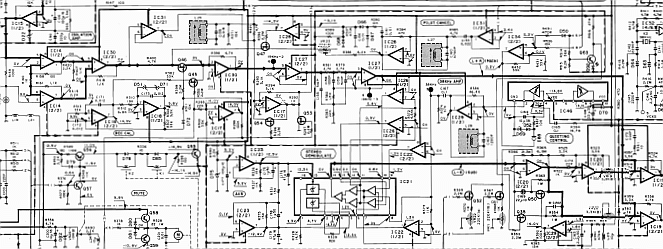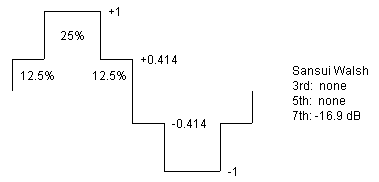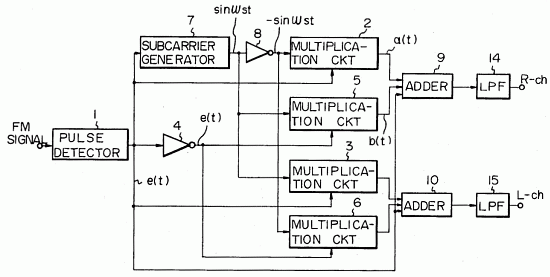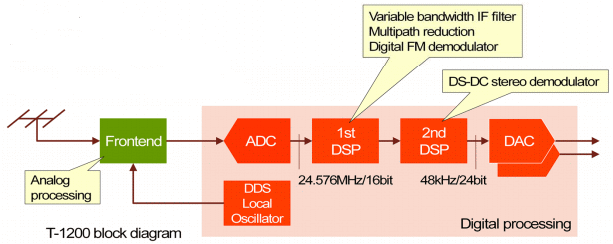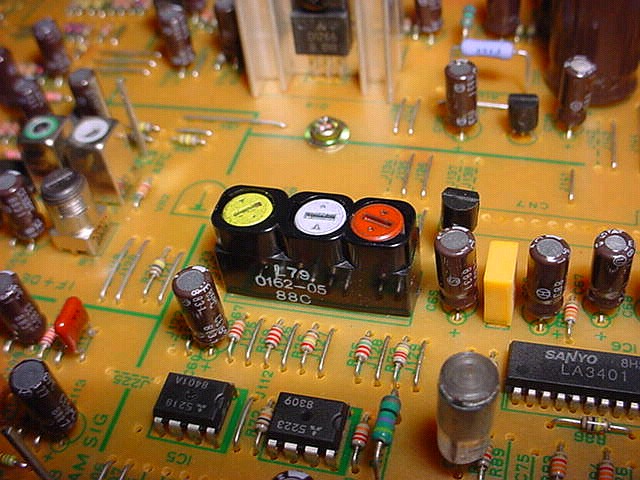Thanks for the tuner list. I do have at least 2 or 3 HD stations so would want post detection filtering ideally or some kind of HD filtering.
Post detection filtering works the best.
HD Radio Self-Noise
You arrive home from a long day at work, flip on the classic stereo system you've spent nights and weekends restoring to perfection, and tune to an FM broadcast of a live local concert. As you settle back to enjoy it, you notice something peculiar. The normally pristine audio from a station that prides itself on a high-quality signal has an annoying background noise. You check your directional rooftop antenna, but it's aimed right at the station not more than ten miles away. Your tuner's signal-strength meter is pegged to the right, as usual. What gives? Then you vaguely recall an announcement that the station soon would begin transmitting HD Radio.
HD Radio Signals
In its current hybrid implementation, HD Radio adds digital sidebands to an analog FM signal. The sidebands consist of hundreds of digital subcarriers that occupy spectrum 129 to 198 kHz each side of channel center. Extended hybrid mode MP3 adds more subcarriers down to 116 kHz. The FCC originally authorized total sideband power at 20 dB below the analog carrier level, or −20 dBc. Later it authorized levels of −14 dBc for most stations and −10 dBc with special permission.
This is the RF spectrum of an HD Radio signal with digital sidebands at −20 dBc. The horizontal scale is 50 kHz per division and the vertical scale is 10 dB per division.
Although the digital sidebands occupy spectrum beyond the normal bandwidth of an analog signal, they remain outside the receive passband of other channels that may be locally allocated. But they can interfere with reception of a distant station on an adjacent channel 200 kHz away. FCC rules do not protect long-distance reception from interference.
An HD Radio station's digital sidebands can interfere with reception of its own analog signal in two ways. First, FM detection can generate intermodulation products between the digital sidebands and the analog modulation. Dave Hershberger analyzes this issue
here. Interference also can occur when the stereo decoder demodulates the digital sidebands along with the L−R signal. This form of HD Radio self-noise is the subject of this article.
Squarewave Stereo Decoding
A stereo encoder lowpass-filters the left and right audio channels to 15 kHz and adds them to form the L+R signal. It subtracts them to get L−R and amplitude modulates this signal onto a 38 kHz subcarrier. The encoder suppresses the subcarrier and replaces it with a phase-coherent 19 kHz pilot. It combines these signals to form a composite signal with L+R to 15 kHz, pilot at 19 kHz, and L−R from 23 to 53 kHz. The composite signal frequency-modulates the RF carrier.
To recover the left and right channels, a receiver detects the FM signal and passes the composite signal to the stereo decoder. The decoder phase-locks a 38 kHz oscillator to the 19 kHz pilot, demodulates the L−R signal with the oscillator, and adds and subtracts L+R and L−R to get L and R. Filters eliminate everything above 15 kHz.
An ideal way to demodulate the L−R signal is with a product detector. Multiplying the composite signal by a 38 kHz sine wave phase-locked to the 19 kHz pilot yields L−R at baseband plus ultrasonic products that are filtered away. This demodulator has no inherent spurious responses. Practical issues include linearity, temperature stability, sinewave purity, complexity, and cost.
IC stereo decoders instead use synchronous signal inversion. The composite signal is unaltered then inverted at a 38 kHz rate synchronized to the 19 kHz pilot. Constant amplitude eliminates the need for an analog multiplier. In effect this approach multiplies the composite signal by a 38 kHz square wave with amplitude levels of +1 and −1. A square wave contains odd harmonics of the fundamental frequency, in particular the third at 114 kHz and the fifth at 190 kHz. But since the transmitted stereo composite signal has no components near these frequencies, it decodes like a product detector.
The problem with squarewave decoding is that HD Radio signals have power near 190 kHz after FM detection. Extended hybrid signals have additional power near 114 kHz. When the squarewave harmonics demodulate this power to baseband, audio noise results.
Special Stereo Decoders
Product Detector Despite its cost and complexity, a few high-end tuners use a product detector. This Kenwood L-1000T circuit uses a Motorola MC1594 four-quadrant multiplier and many other parts.
Harmonic Canceller A switched, multilevel waveform can
eliminate one or more squarewave harmonics without resorting to sinewave multiplication. The four-level Walsh function waveform shown above, generated by a discrete Sansui
stereo decoder, has no third or fifth harmonic. The seventh harmonic at 266 kHz is beyond the spectrum of detected HD Radio sidebands.
Digital Direct Decoder Pioneer's patented
decoder uses two proprietary ICs and includes a pulse-count FM detector. Reversing roles, the binary composite signal passes or inverts a 38 kHz sine wave locked to the 19 kHz pilot. Since the pulse rate is above 1 MHz, spurious responses lie well beyond the spectrum of detected HD Radio sidebands. The multiplication circuits are analog switches, not four-quadrant multipliers.
Digital Signal Processing When the composite signal is decoded with DSP, anti-alias filtering and stereo decoding by numerical product detection can reject detected HD Radio sidebands.
Noise Level
The HD Radio self-noise level depends on the service mode, digital sideband level, receiver IF bandwidth, postdetection filter, and stereo decoder. For a receiver with two wideband ceramic IF filters, no postdetection filter, and squarewave stereo decoder, HD Radio self-noise for MP1 hybrid mode at −20 dBc is roughly
50 dB below the level of a 100%-modulated, 1 kHz sine wave. It is down about 44 dB for extended hybrid mode MP3. These noise levels increase in direct proportion to the digital sideband level.
HD Radio self-noise is particularly audible in speech and during quiet passages in music. I've measured program levels as low as 25 dB below a 100%-modulated, 1 kHz sine wave in classical music. S/N for these passages may be just 50 − 25 = 25 dB for MP1 mode at −20 dBc. This explains why I've found signals with HD Radio self-noise unlistenable on every tuner I've tried that lacked a special stereo decoder, narrow IF filter, or postdetection filter.
IF Filters
Some home tuners are more elaborate, but many use a cascaded pair of 280 kHz ceramic IF filters. This shows the detected spectrum in one such tuner when receiving an HD Radio signal. The horizontal span is 200 kHz and the vertical scale is 10 dB per division. The program material was monophonic. From the left the signals are L+R, pilot, residual L−R near −30 dB, RDS, and two SCAs. To the right are the detected HD Radio sidebands.
The HD Radio spectrum, flat at RF, rises 6 dB per octave after FM detection. The roll-off of cascaded 280 kHz IF filters matches the rise around 150 kHz, and the filters take over above. But the spectrum is not down much between 175 and 198 kHz, the region a squarewave stereo decoder will demodulate to 15 kHz or less with its fifth harmonic at 190 kHz.
Narrower IF filters make quite a difference. This shows overlapped spectra for three different sets of IF filters in one tuner. The traces are for pairs of 280, 180, and 150 kHz filters. The differences in the HD Radio spectral level are pronounced, as are the differences in audible self-noise. The effect of IF filters is more fully explored
here.
Narrow IF filters increase harmonic distortion, exaggerate multipath distortion, decrease modulation acceptance, and degrade stereo separation. Elevated multipath distortion can be quite audible. Less noticeable are ticks and pops on audio peaks for stations that overdeviate. Higher harmonic distortion and lower stereo separation are measurable but not necessarily
audible. Some tuners include circuitry to maintain separation in narrow.
Postdetection Filter
Few home tuners made for the U.S. market provide a dedicated lowpass filter between the FM detector and stereo decoder. Most just use a capacitor to suppress IF ripple. Audio bandwidth and stereo separation depend on the amplitude and phase response of the 53 kHz composite-signal passband. A postdetection filter with significant attenuation above 100 kHz must be carefully designed to maintain flat composite response. Nevertheless, some tuners do use such filters. Some are complex designs with response nulls at 114 and 190 kHz.
This passive postdetection filter in a Kenwood
KT-880D tuner completely eliminates HD Radio self-noise.
Postdetection filters sometimes are called
birdie or
anti-birdie filters when intended to prevent the demodulation of extraneous composite signals as tones. Such filters may or may not be effective against HD Radio self-noise. While some are complex lowpass filters, others are just simple LC traps resonant at the 67 kHz SCA frequency.
The European version of a tuner often includes a postdetection filter the U.S. version lacks. The filter reduces interference from adjacent-channel signals in the crowded European FM spectrum. These filters may reduce or eliminate HD Radio self-noise.
Reducing HD Radio Self-Noise
Mono The easiest way to eliminate HD Radio self-noise is to hit the mono button. The noise corrupts only the stereo subchannel. If you don't use it, no noise will appear. Most public radio programs use monophonic audio. Some stations drop the stereo pilot for these programs, causing your tuner to revert to mono and any HD Radio self-noise to disappear. For stations that retain the pilot, press the mono button to eliminate the noise.
Hi-Blend If a signal has stereo content and you'd like to preserve some of it, engage
hi-blend. This filter rolls off the highs of the L−R signal before combining it with L+R, typically providing 3–6 dB of noise reduction and 10–20 dB of midrange stereo separation. Hi-blend noticeably quiets the audio while retaining a decent stereo effect. However, HD Radio self-noise will remain audible unless the listening level is low.
Narrow IF Filter If your tuner has a selectable narrow IF bandwidth, try it. Even if this just cascades additional wideband filters to improve alternate-channel selectivity, it should lower HD Radio self-noise. Filter bandwidths of 180 kHz or less will drop it substantially. Using a narrow filter may not eliminate the last trace of noise, but the result may be good enough at moderate listening levels.
Although narrow filters measurably degrade audio fidelity, I've never been able to hear a difference in sound quality between wide and narrow IF filters on speech or music in a properly aligned tuner. Exceptions are when receiving multipath-laden or overdeviated signals. You may occasionally object to the sound of a narrow IF filter, but the reduction in HD Radio self-noise can be well worth it.
You can retrofit your own tuner with narrow ceramic filters. Digi-Key and Mouser stock surface mount parts, which can be adapted. Leaded filters are available on eBay. Lowest distortion and best performance require filter characterization and tuner realignment. But if you obtain a dozen filters and a breakaway in-line socket strip with which to make three-pin filter sockets, you can swap filters until you're satisfied with the sound. You may need to adjust the muting and stereo thresholds to compensate for higher filter loss.
Postdetection Filter A solution with negligible sonic penalty is to add a postdetection filter. You can build one and install it yourself.
This design should eliminate self-noise for any HD Radio signal. Details are
here.
Tuner The last solution is simply to buy another tuner. Few home tuners are marketed these days, but high-quality used tuners are readily available.
Receiving an HD Radio signal in stereo at full IF bandwidth without self-noise requires a postdetection filter or special stereo decoder. The U.S. version of each tuner listed below has one or the other, or both. Before buying a tuner, check with someone who owns one to verify the effectiveness of its self-noise rejection. Surely the list is incomplete.
These tuners did not make the list.
Postdetection Filter
ADS T2
Aiwa AT-9700
Akai AT-93 AT-K03 AT-S55 AT-V04
AMC T7
Arcam Alpha 5 Plus Alpha 7 Alpha 8 T21 T51
Audiolab 8000T
Carver TX-11
DaySequerra FMR 25
Denon TU-600 TU-650RD TU-660 TU-680NAB TU-767 TU-800 TU-1500RD UTU-F10
Dynaco AF-6
Heathkit AJ-15
Hitachi FT-007 FT-3500 FT-4400 FT-5500MKII FT-8000
Kenwood 600T BASIC T2 KT-9XG KT-80 KT-615 KT-770 KT-880D KT-900 KT-917
KT-1000 KT-1100 KT-3050 KT-5020 KT-6040 KT-6050 L-01T L-02T L-07TII
Klein + Hummel FM 2002
KLH Eighteen
Luxman T-117 T-230 T-240 T-400 TX-101
Marantz 2130 ST-8 ST-17 ST551
McIntosh MR71 MR73 MR74 MR77 MR78
NAD 4155 4300
Onkyo T-35 T-407 T-450RDS T-909 T-4017 T-4057 T-4087 T-4150
T-4500 T-4700 T-4711 T-9060 T-9090 T-9090II T-G10
Phase Linear T 5200
Philips AH180 FT930
Pioneer F-9 F-X700 TX-05 TX-950 TX-8500II TX-9100
Quad FM3
Revox B160 B260 B260-S B261 B760 H6
Rotel RHT-10 RT-830A RT-850 RT-850A RT-870 RT-940AX
RT-950BX RT-955 RT-970BX RT-990BX RT-1080
Sansui TU-517 TU-717 TU-719 TU-919 TU-S5 TU-S9 TU-S55X TU-X1
Sony ST-J55 ST-J75 ST-S555ES
Sumo Charlie
TAG McLaren T32R
Technics ST-G7
Product Detector
Kenwood KT-990D KT-990SD KT-1100SD KT-3300D KT-7020 L-1000T
Rotel RHT-10 RT-990BX
Yamaha T-85 TX-1000 TX-2000
Harmonic Canceller
Denon TU-680NAB
NAD C420 C422 C425 C426 S400
Onkyo T-405TX T-405X
Primare T21
Sansui TU-D99X TU-D99AMX TU-S77X TU-S77AMX
Digital Direct Decoder
Pioneer F-51 F-77 F-90 F-91 F-93 F-99X F-401 F-449 F-656 F-717
Digital Signal Processing
Accuphase T-1000 T-1100 T-1200
Sound Samples
I recorded this sound sample from a Proton 300 table radio. It used three 280 kHz IF filters, no postdetection filter, and a squarewave stereo decoder. The RF signal level was 73 dBf, the digital sideband level was −14 dBc, and the HD Radio service mode was MP3:
This is the same station with 180 kHz filters replacing the 280s:
January 26, 2025
88–108 MHz


